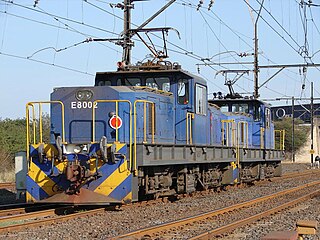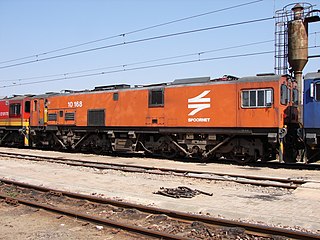
The South African Railways Class 6E of 1970 was an electric locomotive.

The South African Railways Class 6E1, Series 2 of 1971 was an electric locomotive.

The South African Railways Class 6E1, Series 4 of 1973 was an electric locomotive.

The South African Railways Class 6E1, Series 5 of 1974 was an electric locomotive.

The South African Railways Class 6E1, Series 6 of 1976 was an electric locomotive.

The South African Railways Class 6E1, Series 7 of 1977 was an electric locomotive.

The South African Railways Class 6E1, Series 8 of 1979 was an electric locomotive.

The South African Railways Class 7E is an electric locomotive. South African Railways placed 100 Class 7E electric locomotives with a Co-Co wheel arrangement in service in 1978/79. They were the first 25 kV AC locomotives to enter service in South Africa.

The South African Railways Class 7E2, Series 2 is an electric locomotive. South African Railways placed 40 Class 7E2, Series 2 electric locomotives with a Co-Co wheel arrangement in service in 1983.

The South African Railways Class 8E of 1983 is an electric locomotive.

The South African Railways Class 10E1, Series 1 of 1987 is an electric locomotive.

The Spoornet Class 10E1, Series 2 of 1990 is a South African electric locomotive.

The South African Railways Class 10E2 of 1989 is an electric locomotive.

The Spoornet Class 16E of 1990 was a South African electric locomotive.

The Spoornet Class 17E of 1993 was a South African electric locomotive.

The Spoornet Class 18E, Series 1 of 2000 is a South African electric locomotive.

The Transnet Freight Rail Class 18E, Series 2 of 2009 is a South African electric locomotive.

The South African Railways Class 6E1, Series 9 of 1981 was an electric locomotive.

The South African Railways Class 6E1, Series 10 of 1982 was an electric locomotive.

The South African Railways Class 6E1, Series 11 of 1984 was an electric locomotive.






























